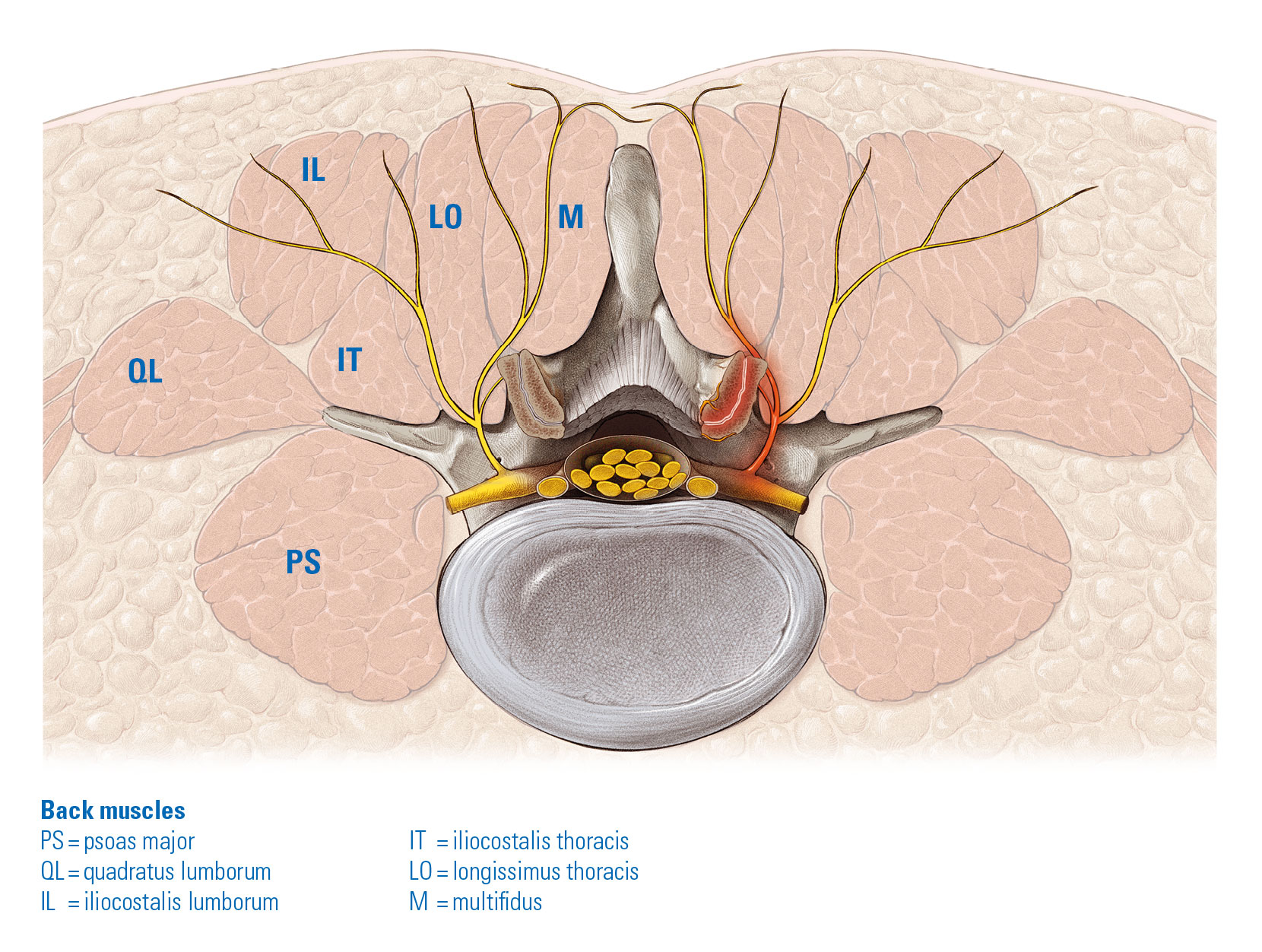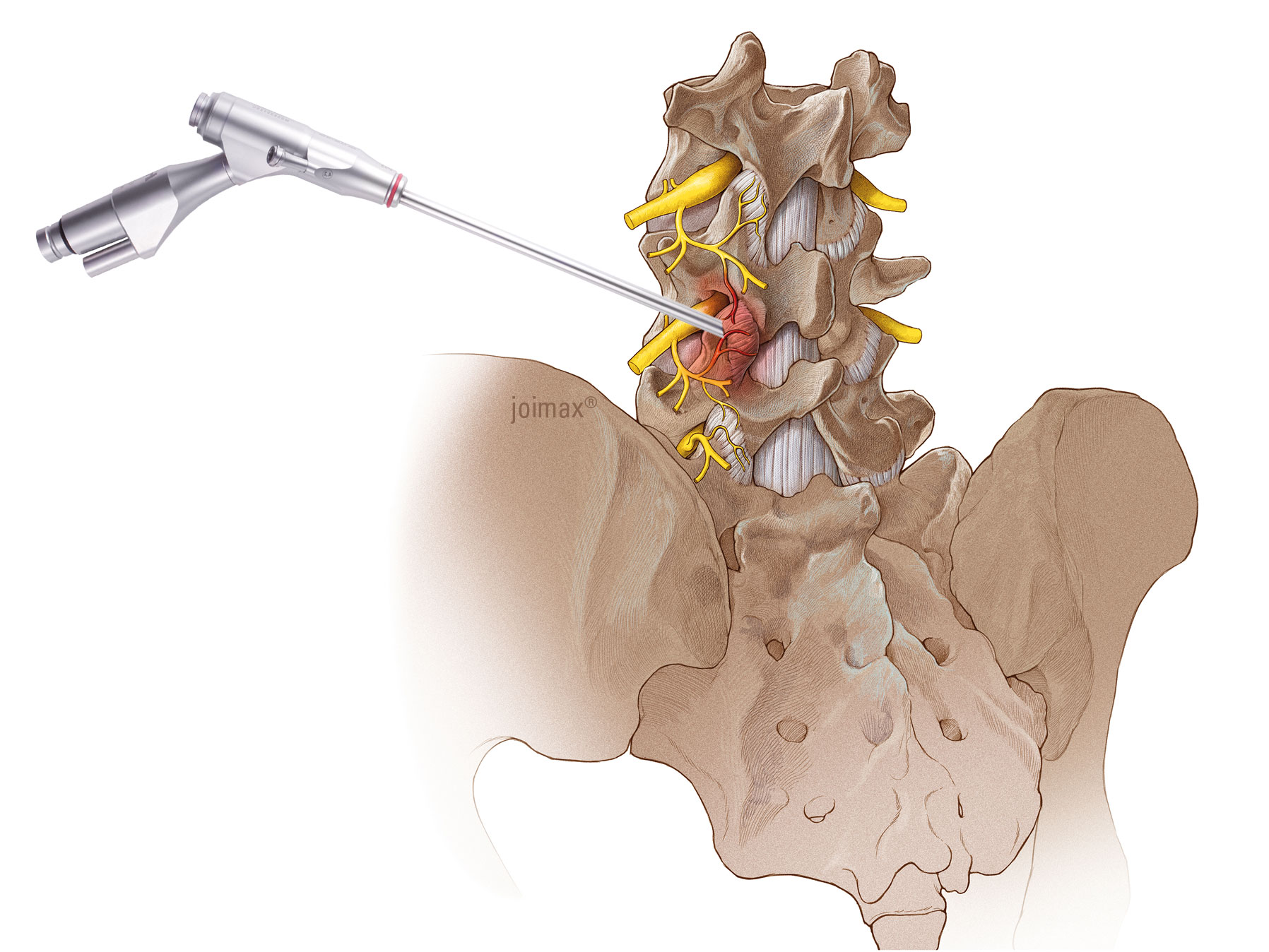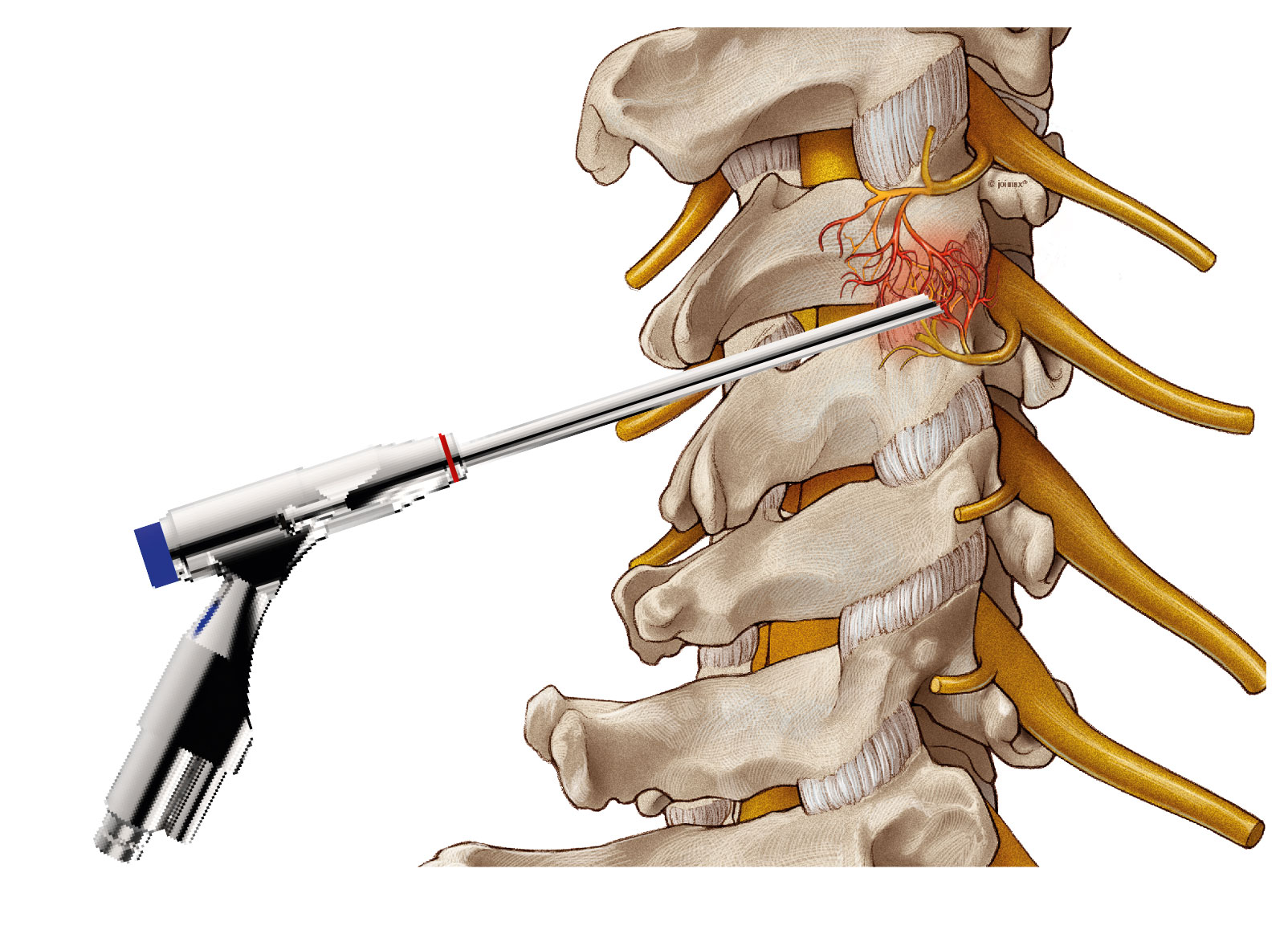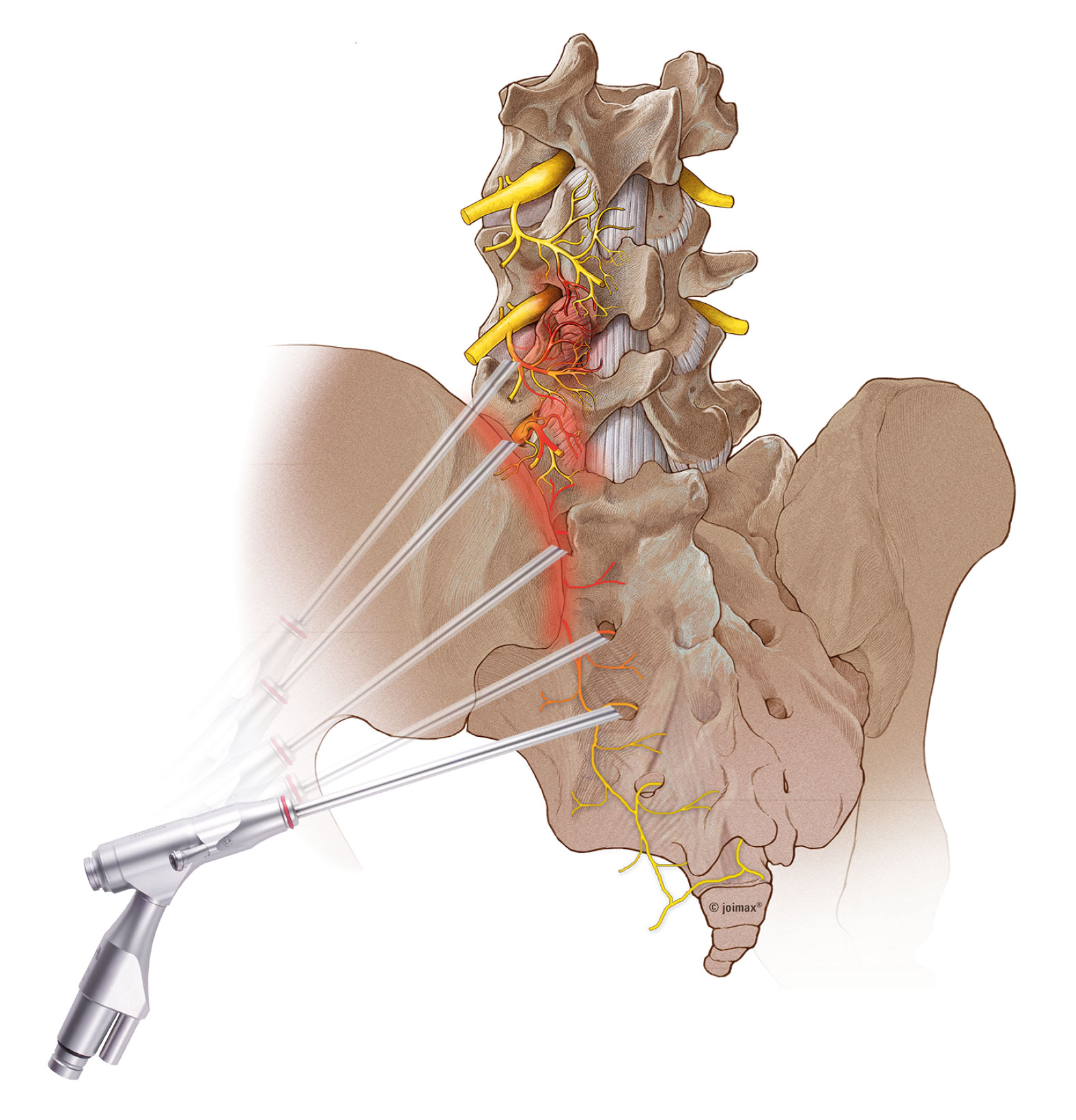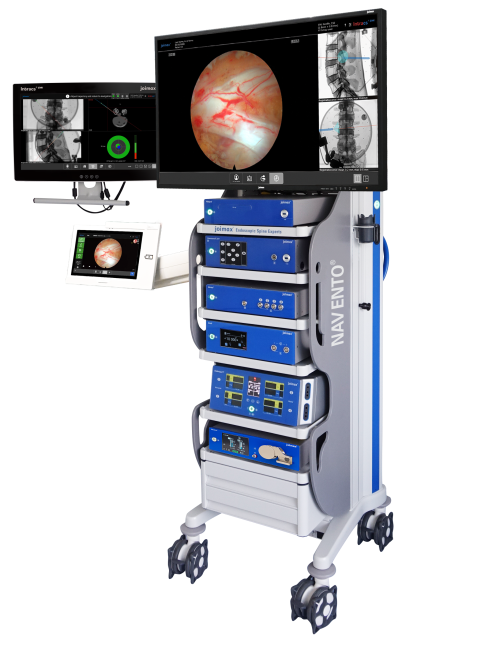Pain Therapy
Three proven methods are available to surgeons for minimally invasive endoscopic pain treatment: MultiZYTE® Facet for the treatment of facet joints and MultiZYTE® SI for the treatment of the sacroiliac joint (SIJ). We also offer intENTS® nucleus therapy for the interventional and intradiscal endoscopic treatment of nerve compression and discogenic pain in the cervical and lumbar spine.
The MultiZYTE® Concept
With chronic facet syndrome, doctors and patients often face massive challenges. While vertebral fusion severely restricts the patient’s mobility and can lead to far-reaching subsequent complaints due to scarring in conventional procedures, more conservatice injection procedures often fall short and only provide short-term pain relief.
With MultiZYTE®, joimax® offers an alternative that not only provides long-lasting pain relief but also maintains almost full mobility. The MultiZYTE® method directly eliminates the source of pain by means of percutaneous neurotomy of the ramus dorsalis medialis ; safely and under endoscopic control. By opening and rinsing the joint capsule as well as optionally cutting of hypertrophic mamillo-accessory ligament (MAL), further pressure is also removed from the facet joint and nerve structures.
Benefits of endoscopic pain treatment methods
• Long term therapeutic success due to
endoscopically controlled approach
• Treatment of joint capsule with irrigation and vaporization
• Effective, precisely focused treatment using RF ablation
• Small incision, therefore minimal scar formation
• Short regeneration period
• Can be performed under local anesthesia
• Spinal and sacroiliac mobility is preserved
• Treatment at multiple levels possible with one incision
Endoscopic Facet Joint Treatment with MultiZYTE® Facet
After gentle, minimally-invasive access, the treatment with MultiZYTE®Facet involves the removal of hypertrophic and infl amed tissue, opening of the joint capsule, irrigation as well as vaporization of the joint, and the RF ablation of pain-conducting nerves of the medial branch of dorsal ramus.
Selected Indications
• Chronic lumbar back pain
• Facet joint hypertrophy
• Facet joint arthritis and osteoarthritis
• Post-discectomy syndrome
• Cervical spine trauma
MultiZYTE ® Facet Cervical
Endoscopic treatment of cervical facet joint
While endoscopic facet joint treatment for the lumbar and thoracic area is already enjoying increasing popularity, cervical application is still a challenge for most surgeons. With MultiZYTE® Facet Cervical joimax® therefore takes the next step in pain therapy and enables endoscopic facet joint treatment also in the cervical area.
Selected Indications
• Chronic neck pain
• Facet joint hypertrophy
• Degenerative diseases of the facet joint
• Postdiscectomy syndrome
• Discogenic cervical headache
MultiZYTE® Sacroiliac – Pain therapy for the lower back
Thanks to endoscopic denervation, joimax® MultiZYTE® Sacroiliac can be used for targeted pain therapy for various forms of pathological changes to the SI joint.
The prevalence of SIJ syndrome in diagnosed back pain is 15 % to 30 %.1 After previous lumbar surgery, this can be much higher, especially in the case of lumbar or lumbosacral fusion. In patients with previous lumbosacral fusion, the prevalence of SIJ-related pain is 43%, making it one of the most common causes of back pain.2
Typically, sacroiliac joint syndrome presents as unilateral or bilateral lumbosacral back pain, which can be greatly exacerbated by certain movements and also by prolonged lying down. It can also radiate into the buttocks or thigh. On average, 45% of cases affect the right SIJ and 35% the left. Bilateral symptoms can be detected in 20 % of the cases examined.3 The reason for this is the significantly higher incidence of degenerative changes in the sacroiliac joint after lumbar or lumbosacral fusion, namely 75 % compared to 38.2 % in the control group.4
Selected Indications
• Chronic lower back pain
• Painful, degenerative changes of the sacroiliac joint, e.g. SIJ-arthrosis
• Postoperative complaints following a previous lumbar operation
• Hypermobility of the SI-Joint due to ligamentous laxity
• SI-Joint trauma
• Inflammation of the SI-Joint
• Static overload syndrome
Benefits of endoscopic pain treatment methods
• Long term therapeutic success due to endoscopically controlled approach
• Treatment of joint capsule with irrigation and vaporization
• Effective, precisely focused treatment using RF ablation
• Small incision, therefore minimal scar formation
• Short regeneration period
• Can be performed under local anesthesia
• Spinal and sacroiliac mobility is preserved
• Treatment at multiple levels possible with one incision
Disclaimers
Certain products may not be approved for sale in all countries.
Disclaimers
Certain products may not be approved for sale in all countries.
Bibliography
1. Cohen SP et al. Sacroiliac joint pain: a comprehensive review of epidemiology, diagnosis and treatment. Expert review of neurotherapeutics 13.1 (2013): 99-116.
2. DePalma MJ et al. Etiology of chronic low back pain in patients having under-gone lumbar fusion. Pain Medicine 12.5 (2011): 732-739.
3. Bernard TN et al. The sacroiliac joint syndrome: Pathophysiology, diagnosis, and management. In: Frymoyer JW, ed. The Adult Spine: Principles and Practice 2nd ed. Lippincott-Raven Publishers, Philadelphia (1997): 2343-2363.
4. Ha KY et al. Degeneration of sacroiliac joint after instrumented lumbar or lumbosacral fusion: a prospective cohort study over five-year follow-up. Spine 33.11 (2008): 1192-1198.
NAVENTO® Knows No Boundaries!
NAVENTO® – The fully integrated, new generation endoscopic navigation tower for the whole range of applications. It offers the complete package with latest technology and coordinated functionalities of all devices.
This enables the user to master endoscopic spinal surgery in all its diversity and offers growth potential for the expansion of skills and indications.
NAVENTO® knows no boundaries!
